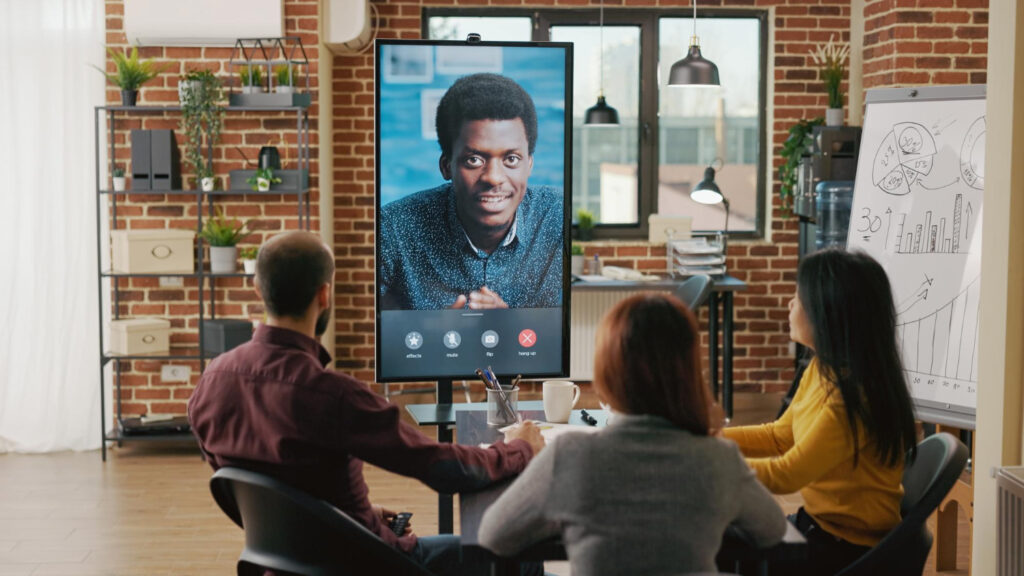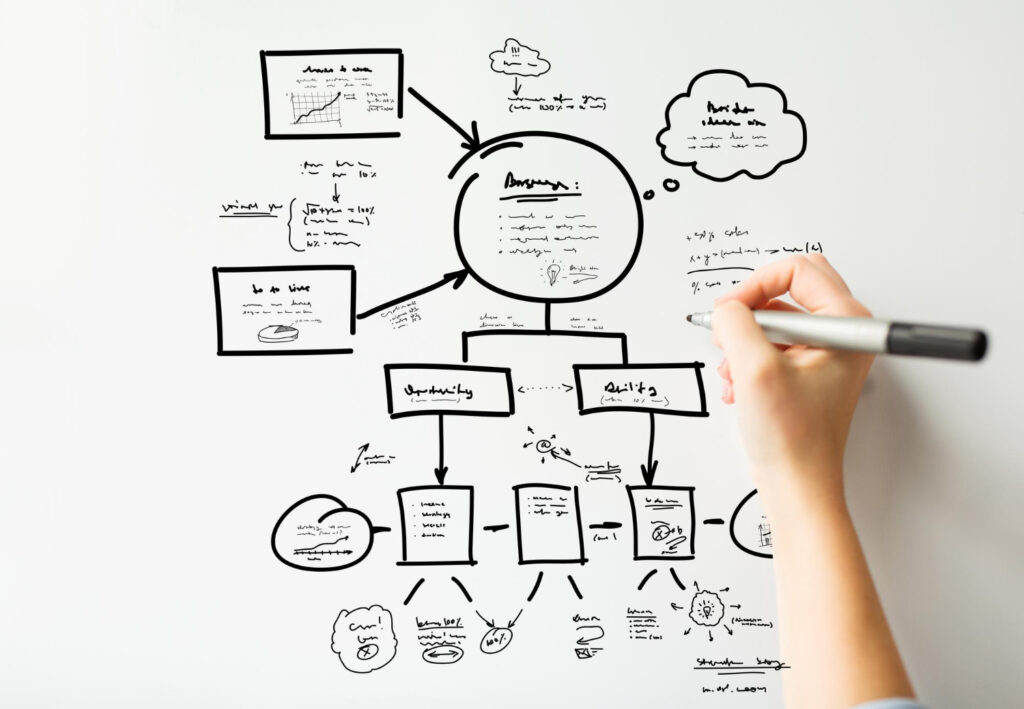Unlock your team’s creative potential with our five top brainstorming session strategies (and a few bonus suggestions). Learn to navigate the challenges of modern brainstorming with a mix of cutting-edge tools and techniques that make every session more dynamic, productive, and inclusive, no matter where your team is located.
Key Takeaways
- Capitalize on SCAMPER and mind mapping techniques to foster creative thinking and visualization, enabling teams to innovate by exploring various angles and connecting ideas.
- Utilize hybrid brainstorming tools like ShareTheBoard to bridge the divide between in-person and remote collaboration, ensuring all team members can contribute effectively and equally.
- Encourage a culture of innovation by promoting open communication, celebrating successes, and embracing failure as a learning opportunity to motivate and retain employees.
Brainstorming in the Digital Age

Many of us now find ourselves collaborating online, requiring tools and methods that can support our evolving work styles. On the other hand, the return to office life has rekindled the potential of in-person brainstorming sessions, allowing us to leverage certain tools and techniques that weren’t always accessible from a distance.
This hybrid work scenario, a blend of remote and in-person collaborations, has its own unique challenges. Fear not, as new tools are continuously being developed to maintain productivity amidst these evolving circumstances. Now, it’s time to delve into ideation methods that can be applied in any work mode and explore the tools and techniques best suited for each scenario.
Creative Thinking Techniques to Boost Idea Generation
Let’s dive right in and consider three specific brainstorming techniques – to be applied in any ideation scenario.
SCAMPER
In the realm of ideation, SCAMPER has surfaced as a potent creative thinking method, guiding teams to innovate by tweaking existing ideas. This acronym, representing seven different strategies, nudges us to:
- Substitute – Are there elements that could be replaced? Which ones and to what end?
- Combine – Are there elements that could be put together? What efficiencies might this unlock?
- Adapt – Can an existing element gain a new feature or function?
- Modify – What are the effects of adjusting key characteristics of existing elements?
- Put to other uses – Does the discussed element have an application in another context?
- Eliminate – Is there any element that could be removed or greatly reduced/simplified?
- Reverse or rearrange – Would redesigning or reversing a key process yield added value?
The components of an idea are crucial, and utilizing a non-linear approach allows for as many ideas to be considered, encouraging both logical and unconventional inputs, fostering creative thinking and generating new ideas alongside creative ideas.
Mind Mapping

Imagine having a tool to organize information, connect related ideas, and capture the flow of thoughts. Welcome to mind mapping, a technique designed to simplify complex relationships and improve the retention of information. Its sequential structure facilitates learning new concepts by linking them to existing knowledge, making the entire learning process interactive and engaging.
Mind mapping breaks down intricate relationships into an easy-to-follow structure, simplifying the understanding of how various ideas interconnect. The engaging structure of mind maps makes the learning process more interactive, helping commit information to memory.
Six Thinking Hats
Imagine a brainstorming session where every participant dons a different colored hat, each color representing a unique perspective to approach a problem. This is the essence of the Six Thinking Hats technique, a parallel thinking method that stimulates participants to explore various viewpoints, and think outside the box.
- White hat – What are the facts?
- Yellow hat – What are the opportunities, benefits and strong sides?
- Black hat – What are the risks, threats, and weaknesses?
- Red hat – What emotions does the topic at hand elicit?
- Green hat – What new, creative ideas could add value?
- Blue hat – What are the next steps?
The Six Thinking Hats method bolsters team collaboration and productivity by providing a structured framework for:
- Conflict-free engagement
- Careful problem analysis
- Objective thinking devoid of personal biases
- Expedited, efficient decision-making.
The method involves a facilitator who guides the participants through the process, ensuring that all hats are used effectively to consider all perspectives and keep the session on track.
Harnessing Hybrid Brainstorming Sessions
Even with the post-pandemic return-to-office push, remote work is on the rise. This fact, coupled with the many other reasons why people may collaborate remotely often results in brainstorming sessions that face a partially-distributed or hybrid working situation. Digital tools often prioritize a digital-first experience which may not align well with creative processes. Furthermore, they risk eliminating the benefits of physical proximity of in-person participants.
Luckily, a new category of hybrid collaboration tools is now emerging. As the leader in this space, ShareTheBoard overcomes the challenges of hybrid collaboration by providing a more natural and inclusive brainstorming environment for all participants. ShareTheBoard is designed to merge the tangible benefits of traditional whiteboards with the efficiency of digital solutions in a hybrid work environment.
Overcoming Remote Brainstorming Challenges

Brainstorming in remote and hybrid contexts is challenging due to the diminished effectiveness of close proximity during the ideation process. ShareTheBoard’s content amplification feature ensures that handwritten content remains visible and legible in real time for all remote participants. This means that teams can use time-tested brainstorming tools such as whiteboards, even when many participants aren’t physically present.
Using the world’s best handwritten content detection algorithms, ShareTheBoard facilitates the digital sharing of traditional writing surfaces, bridging the gap between analog and digital brainstorming methods. This innovative approach ensures everyone, regardless of their location, can see and contribute to the whiteboard effectively.
Blurring the Boundary Between Analog and Digital
ShareTheBoard’s technology is part of a new category of tools developed for hybrid collaborations, aiming to maximize the use of traditional tools such as whiteboards and digitize their content for remote participants. The obstacle avoidance technology in ShareTheBoard makes presenters appear transparent to remote viewers, enhancing the clarity of the whiteboard for distant partners.
ShareTheBoard offers the following features:
- Interactivity features that permit remote colleagues to zoom in on the board or save its contents
- Secure content contributions
- Digitize handwritten contents with a single click, transforming board scribbles into digital text, tables, code, and flow charts
- Turn any analog tool into a digital input, eliminating the boundary between the offline and the online.
Engaging in Effective Virtual Brainstorming Sessions

Establishing clear expectations and goals with participants prior to initiating a virtual brainstorming session can provide a solid foundation for a focused and orderly discussion. Begin the brainstorming session with icebreakers to ease participants into a creative mindset and promote a comfortable environment.
Employ a variety of brainstorming techniques, such as reverse brainstorming and word association, to generate ideas and leverage whiteboards or visual collaboration platforms like Mural to make virtual group brainstorming sessions interactive and engaging. One effective brainstorming technique is initiating smaller group discussions in breakout rooms during an online brainstorming session to encourage individual thinking and prevent groupthink.
Pose ‘what if’ questions and draw connections between seemingly unrelated ideas to prompt creative and critical thinking in participants.
Round Robin Brainstorming
Round Robin brainstorming guarantees equal contribution opportunities for each team member, thereby promoting inclusivity and diversity of perspectives. This technique encourages participants to freely share any idea, regardless of how unconventional, within a judgment-free zone.
This method of brainstorming increases team engagement and can be particularly effective in remote scenarios, encouraging more active participation. By generating more potential solutions through Round Robin brainstorming, teams enhance their problem-solving capacity and may discover game-changing ideas.
Crazy Eights Template
The Crazy Eights technique requires participants to quickly sketch eight distinct ideas on a template within a brisk eight-minute timeframe. By setting a strict time limit, the Crazy Eights method encourages rapid idea generation, reducing self-censorship and promoting a competitive, supportive team environment.
This method has a specific structure, requiring each participant to focus on eight ideas, which ensures everyone contributes effectively while staying on topic. For larger group settings, the Crazy Eights template can be easily replicated across multiple tables within a brainstorming template, accommodating a greater number of participants.
Tools and Integrations to Enhance Collaboration
You could write an entire book on tools for online collaboration. Here are just a few categories to begin your search, along with examples of each:
First, there’s the group that calls itself productivity platforms. Here you’ll find solutions such as Monday or ClickUp. These provide a wide selection of brainstorming templates addressing various aspects of project management, including idea collection and tracking.
For purely online brainstorming sessions, consider using online collaboration tools like Mural and Miro, as well as video conferencing apps like Zoom or MS Teams, for a semblance of the in-person brainstorming experience.
The lines between these categories often get blurred. Many brainstorming tools, for example, use anonymous voting to enable teams to quickly gain alignment on ideas, then supplement those interactions with features aimed at managing the project lifecycle. Some even have video conferencing built-in. Do your research to find the tools that are right for your team. Below are a few prompts to get you started.
Video Conferencing Apps

Video conferencing apps like Zoom and Microsoft Teams play a pivotal role in facilitating virtual brainstorming sessions by providing reliable and collaborative online spaces.
Some key features of Zoom include:
- Robust video calls for large groups
- Collaboration features
- Options for video recording
- AI assistance for tasks
- Smooth integration with multiple other applications
These features are crucial for generating the best ideas during productive brainstorming sessions.
Google Meet offers the following features:
- It can accommodate up to 100,000 view-only participants
- It is fully integrated with Google Workspace
- It offers features like live captions that are valuable for engaging all participants in brainstorming regardless of size.
Jitsi is a complimentary, open-source conferencing solution that offers the following features:
- Requires no account
- Provides a quick and easily accessible option
- Maintains good video quality
- Includes integrations for rapid meeting setup
Visual Collaboration Platforms
Visual collaboration platforms like Miro and Mural offer an infinite canvas, enabling real-time collaboration with features like sticky notes, diagrams, and a variety of formats for brainstorming. These platforms facilitate increased efficiency and agility, aligning teams around a centralized record of ideas and decisions, thereby scaling innovation and enhancing employee satisfaction and engagement.
Visual collaboration platforms support a range of activities including:
- Brainstorming
- Mapping processes
- Diagramming systems
- Advancing strategic initiatives across the project lifecycle
By integrating with popular technologies and offering pre-made templates, these platforms contribute significantly to the workflow, providing a shared space for communication, planning, and recording processes at all stages.
Nurturing a Culture of Creativity and Innovation

Open communication encourages the sharing of varied ideas, kindling creativity and thwarting groupthink. Regular team-building activities enhance trust and openness among team members, which are crucial for creative collaboration. To encourage team members further, it’s essential to maintain this open communication and trust-building environment.
Introducing and valuing different thinking styles, such as explorative and exploitative thinking, can result in more creative solutions and innovations. Diverse teams with a range of professional backgrounds bring varied perspectives that can lead to breakthrough ideas and approaches.
Encouraging Open Communication
Open communication allows employees to:
- Freely express their thoughts and ideas, vital for their engagement and productivity
- Contribute to an inclusive work environment by ensuring that every team member feels heard and valued
- Foster trust and a sense of belonging
Actively responding to employee feedback shows that their contributions are heard and appreciated, which is critical in upholding a culture of open communication.
Celebrating Successes and Learning from Failures
Acknowledging minor victories in the workplace can drastically boost morale and motivate the team, serving as a catalyst for ongoing innovation and collaboration during tough times. Recognition of good work ranges from simple acknowledgments to praise for attempts, even without a successful outcome, considering what’s significant for the team and the individual.
The authentic, natural dispensation of appreciation, timed right, nurtures a genuine spirit of celebration and reinforces a positive team culture. Maintaining the value of recognition requires a delicate balance that steers clear of excessive celebration, thus preserving its meaningfulness and specificity to the deeds and persons being celebrated.
Summary
In the rapidly evolving digital age, brainstorming sessions have transformed from being a physical gathering to an inclusive virtual or hybrid scenario. Through a myriad of creative thinking techniques, innovative tools, and a nurturing environment, brainstorming sessions have become more engaging, fruitful, and strategic. The key lies in choosing the right methods and tools, fostering open communication, and celebrating every milestone, big or small. Let’s continue to keep the brainstorming fire ablaze, sparking innovation and creativity in every corner of our work life.
Frequently Asked Questions
What is the main purpose of brainstorming?
The main purpose of brainstorming is to generate creative and diverse ideas to solve a problem. It encourages out-of-the-box thinking, and the group then refines and merges the ideas to achieve a consensus.
How do you structure a brainstorm session?
To structure a brainstorm session, start by setting an agenda that includes discussing the central topic, generating new ideas, and gaining consensus on the best ideas. Then, follow the agenda to ensure a productive session and achieve valuable results.
What is the SCAMPER technique?
The SCAMPER technique is a creative thinking method that guides teams to modify existing ideas through seven different strategies, encouraging innovation and new perspectives.
How does mind mapping aid in brainstorming?
Mind mapping aids in brainstorming by organizing information, connecting ideas, and capturing the flow of thoughts, which improves knowledge retention and facilitates learning new concepts. So, it’s a valuable tool for brainstorming.
How can teams effectively brainstorm in a hybrid environment?
Tools such as ShareTheBoard are part of an emerging category of hybrid-first collaboration solutions. These tools were built from the ground up to address the unique challenges of brainstorming simultaneously with in-person and remote colleagues.